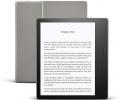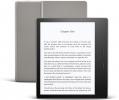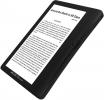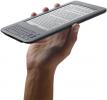Reviews related to : eBook readers
Amazon started life as a book seller, now it sells EBook readers.
Books, a valuable source of information and entertainment, whether in hardback or paperback format, have been around and will continue to do so for many years. However this should not mean that new, or more recent concepts with regards literature, should be ignored. Not only does the digital format of text presentation provide the means to read literature but it also delivers additional information concerning the story and its author.
Regular readers will have seen recently a Kindle review, this Kindle called Oasis, it is very different in shape and it is the first I have seen with a front light. So can this change merit the far higher price of the unit over even the 8th Generation unit?
The Kindle Oasis 2 from Amazon measures 15.8x14cm and weighs 189 grams; the first 5cm of the width is .7cm thick about the same as most newer SmartPhones however the rest of the width is harf that this is the part with the viewable screen that is 14x10.5cm. However if you hold it the other way up so the thicker part is on the right the screen turns round to support this. The viewable screen is 10.5x14cm which gives the notional diagonal imperial measurement of 7 inches.
I must be getting old as I remember the very first Kindle. These days so many people are reading them on the bus or train, what you rarely see is a real book being read. The kindle of course has a huge advantage over a book be it hardback or paperback in that they weigh even less and for good measure you do not have to turn over the corner of a page it knows where you got to.
The latest iteration on the Kindle e-book reader measures 16x11x.8cm and weighs 168 grams. The viewable screen is 11.2x9.2cm. At the default font size this can show 20 lines of text with the addition of percentage of book read and other information below this. This Kindles display is 6 inches from corner to corner.
Providing you with your own personal, portable library is the task of a new eReader from Kobo.
While most of the competition has faded away, for various reasons, as they attempted to battle the might of the Amazon Kindle machine, Kobo continues to fight the good fight. Based in Toronto, Rakuten Kobo is one of the world’s faster growing eReading services with an offering of five million eBooks and magazines accessed by its various eBook readers. A recent addition to the company’s family of eBook readers is the Kobo Aura One device.
While not the only brand on the market, when it comes to referring to an ebook reader many people tend to think of a Kindle device a bit like calling a vacuum cleaner a Hoover.
Amazon has released a number of Kindle ebook reader devices. The latest offering of this product to come my way is the new Kindle Paperwhite model. I mention “new” because this 2015 version of the product is an upgrade of the original version that was launched in 2012, some five years after the original Kindle device was released to the public. My review sample of the Kindle Paperwhite 2015 is the 3G WiFi model that has 4GB of RAM.
As the main competitor to the Amazon Kindle range of eBook readers, Kobo has released it Kobo Glo HD product. Arriving with the claim of being the highest quality eReader at the best possible price, the Kobo Glo HD is, presumably, the companys direct challenger to the Amazon Kindle Voyage, a device I have yet to check out.
The Kobo Glo HD has a 6-inch Carta E Ink HD touch screen that has a high-resolution of 1448 x 1072 pixels which works out at 300dpi. This screen is encased within a body that is made up of a black plastic front and a tough black rubber dimpled back plate. The side bezels are of a size that allows you to get a good grip of the device. While reading you can rest a finger on the bezel ready to be used to activate a page turn either with a swipe or a tap at the edge of the screen.
For those looking for a book reader then the Aura H20 from Kobo could well be something to consider. The bright white background makes it seem just like what one used to take off the bookshelf to read, the main advantage is that text size can suit your eyesight.
The Kobo Aura H20 measures 18x12.5.7cm and weights 228grams. It fits nicely in an adult hand and will slip easily into a bag or purse. The screen is 10.3x17.7cm, the screen in imperial measurements is 6.8inches and the screen is 1430x1080, the default text size gives 25 lines of what looks quite small text but even for someone of advanced years and less than perfect eyesight – me – found is very readable at 40cm distance.
The original Amazon Kindle eBook Reader was quickly followed by the Kindle Touch model. This version, in turn, gave way to the current Kindle offering named the Paperwhite.
My review of the Paperwhite is based on the Wi-Fi model which is the technology used when you need to connect to the Amazon Kindle Store for purchasing your choice of literature. With dimensions of 117 x 169 x 9.1mm (W x H x D) and weighing 213g, this eBook Reader gives you a 6-inch viewable E Ink screen area for your reading material delivered at a native resolution of 1024 x 768 pixels.
As a store within a store, Kobo offers readers a viable alternative to that available from the Amazon Kindle family. Kobo even offers a full fledged tablet option.
The Kobo Arc 10 HD+ could be accused of having a split personality. The device could be considered to be your personal eBook Reader or you might prefer to regard it as an Android tablet with all that that entails. In fact the Kobo Arc 10 HD+ fulfils both of these functions within a single device.
This is the smaller SD version of the Kobo HD that was launched earlier this year. Can this smaller device match what it offered, or does it launch offer even more as it has at least one feature that I have not noticed in other readers.
Size is always important and my first thought was is it big enough. It is 15x11.5x1cm and weights 174grams. However the readable screen is 9x12cm with twenty lines of text in the default font size which is only just big enough for my old eyes but once you get into it then its fine. It certainly fits easily into the palm of your hand. This has the best of both worlds being e-ink and having a backlight the latter will automatically turn off after 15 minutes.
Back in April of this year, Kobo raised the bar on screen quality with the release of its Kobo Aura HD product. This model featured a 6.8-inch WXGA+ Pearl E Ink touch screen with a resolution of 1440 x 1080. Now Kobo has produced another model in the Aura family but this time without the HD capability. This latest product is being pitched against the new Kindle Paperwhite offering
Available in a choice of black or pink, with my review unit being of the former hue, the Kobo Aura is certainly significantly smaller than its HD sibling. In fact, with its dimensions of 150 x 114 x 8.1 mm, it could almost fit within the screen area of the HD model. Befitting its size and weighing just 174g, the Kobo Aura fits comfortably into the hand, helped to a degree by the slightly ridged back of the unit.
This is a rather nice book reader however it can be far more as it is Android based, so you can surf the WWW and collect your emails however for some reason not quite all the content of the Android Play Store is currently available.
The Nook HD+ book reader and general Android tablet measures 24x16x1cm and weighs 500grams. The visible screen is 12.7x19.2cm which gives the notional diagonal imperial measurement of 9inches. As a book reader it is backlit so the battery will not last as long as an e-ink offering. The default font size will show 33 lines of text when in portrait mode; in landscape it will show 20 lines in two columns of just over 7cm (3inches).
A last minute invitation saw me attending the launch event for Kobos latest eReader device.
Adding to is range of eReader products, Kobo has developed its Aura HD Reader. Described as being designed for the world’s most passionate book lovers, the Kobo Aura HD unit is available in luxurious Ivory, Expresso and Onyx. The sample under review is of the Ivory hue. Built around a 6.8-inch WXGA+ Pearl E Ink touch-screen, the Aura HD comes with the claim of offering the highest resolution currently available of 265 dpi at 1440 x 1080. With dimensions of 128.3 x 175.
A somewhat different book reader in that the shape of this near 7inch offering is more like a book with the bulge in the middle makes it easier to hold. It also has a backlight when lack of daylight means you need it.
The Kobo Aura HD eReader measures 17.5x12.7x1cm but the width is only 0.5cm at the edges. The screen is 13.5x10.5cm giving the notional diagonal imperial measurement of 6.8inches. The screen display is 1440x1080 made up of 265DPI. The unit weight is 240grams. It is an e-ink display and according to the Kobo CEO it is the biggest e-ink display in the world. In the box are the Aura HD a micro USB to USB cable and a small Getting Started Booklet. The reader is totally touchscreen.
With its stores within a store, Kobo is certainly making an impression within its designated field of eBook readers.
A few years ago I would spend my time when travelling on the tube either observing other passengers reading newspapers, books or, like me, being squashed by the early morning or evening rush hour crowds. Nowadays, however, newspapers and traditional style books are being overtaken by an influx of e-book readers, tablets and other electronic devices that provide distractions to many travellers.
While almost everyone has heard the name Kindle there are other people who make book readers and one such name is Kobo. In fact they do a whole range of devices here I am looking at two the KoboGlo and the KoboMini.
Either of these would qualify as the smallest dedicated book reader that I have seen so let's start with the larger. The Kobo Glo measures 15.5x11.5x1cm and weighs 183grams. Mine was white with a pinkie red back. It has two buttons on the top a micro USB connection on the base and a micro USB slot near the base of the left side, that is all the connections. The viewable screen is 12.2x9cm.
This book reader is one of the backlit type and so colour is available. Archos have a background in screens, often smaller than this as it was with early devices just larger than phones, but of course they also do computer type items.
The Archos 7od eReader measures 17.5x12.5x1cm, this last figure is at the edges but it bulges so slightly more towards the centre of the back. It weights 277grams. The viewable screen is 8.5x15cm. The top right corner has a 3.5mm jack, just round the corner at the top of the right side are a micro USB port and a micro SD card port. The bottom right edge has the on/off button. All the other controls are to the right of the screen in a single column.
It is not unusual for a product category that has been developed to provide a specific function to undergo a metamorphosis and emerge as a multifunction device covering different tasks. One example of this trend can be seen with eBook readers.
Ebook readers were originally conceived as a means to store your personal library of favourite books allowing you to read the text in digital format. Features such as bookmarks, note taking and electronic dictionaries were added without distracting too much from the original core aspect. Now, however, we are seeing devices appear that place both music and video on an almost equal footing with the eBook capability. Falling into this category is the Binatone Readme Daily product.
Having looked at two earlier models that were only available from Amazon.Com, here after a very long wait I get to sample the joys of the latest sleek offering that at long last is available from Amazon in the UK.
The latest Amazon Kindle measures 19x12x.5cm and weights only 230grams, the viewable screen is 9x12.2cm giving a diagonal screen measurement of 6inches. When off the screen displays one of a range of wonderful monochrome graphics, these graphics use no power. The controls are simple, both the left and right edges have < and > keys to move page forward and page back. The bottom has a volume up and down rocker, 3.5mm headphone/earbud socket a micro USB socket and on/off slider.
Ever since taking a look at the Sony Pocket Reader I have made a conscious effort to watch out for similar devices being used in public areas instead of traditional books and other reading material. Currently these sighting stand at just two instances admittedly over a fairly quiet period with regards to excursions. In neither case was the observed device being the Sony Touch Reader which is the subject of this review
As its title implies, this Sony Reader features a touch screen allowing you to carry out a number of actions using either your finger or the supplied stylus. Following the same pattern adopted by the Sony Pocket Reader, this bigger sibling product arrives in a box that bears more than a passing resemblance to a traditional book.



























